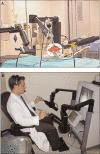Robotically assisted laparoscopic Roux-en-Y hepaticojejunostomy
- PMID: 15347111
- PMCID: PMC3016811
Robotically assisted laparoscopic Roux-en-Y hepaticojejunostomy
Abstract
Introduction: This study evaluates the feasibility and safety of using robotically assisted laparoscopy to perform a Roux-en-Y hepaticojejunostomy. This new method was compared with the open and standard laparoscopic approaches.
Methods: Eighteen pigs underwent a needlescopic common bile duct ligation to create a jaundice model. Three to 5 days later, transabdominal ultrasound was performed, and the common bile duct diameter was documented. For the Roux-en-Y hepaticojejunostomy, the pigs were randomly assigned to the open group (n=6), standard laparoscopy group (n=6), or robotically assisted laparoscopy group (Zeus) (n=6). One surgeon performed all 3 approaches with 1 assistant. Operative times, techniques, and complication rates were documented.
Results: The open approach was faster in all instances. At the hepaticojejunostomy, no difference was noted between the groups with the total number of stitches used. The robot required fewer stitches and less time in the posterior wall of the hepaticojejunostomy (P=-0.0083 and P=0.02049, respectively). The hepaticojejunostomy time was similar for the laparoscopy and robotically assisted groups.
Conclusion: Robotically assisted laparoscopic Roux-en-Y hepaticojejunostomy is a feasible procedure. When compared with standard laparoscopy, operating time is similar.
Figures



Similar articles
-
Approach to manage the complications of choledochoduodenostomy: robot-assisted laparoscopic Roux-en-Y hepaticojejunostomy.Surg Laparosc Endosc Percutan Tech. 2011 Oct;21(5):e228-31. doi: 10.1097/SLE.0b013e318225c98c. Surg Laparosc Endosc Percutan Tech. 2011. PMID: 22002281
-
Totally laparoscopic management of choledochal cyst: Roux-en-Y Jejunojejunostomy and wide hepaticojejunostomy with hilar ductoplasty.J Laparoendosc Adv Surg Tech A. 2011 May;21(4):361-6. doi: 10.1089/lap.2010.0373. Epub 2011 Apr 12. J Laparoendosc Adv Surg Tech A. 2011. PMID: 21486149
-
Totally laparoscopic cyst excision and Roux-en-Y hepaticojejunostomy for choledochal cyst in adults: a single-institute experience of 5 years.Surg Laparosc Endosc Percutan Tech. 2015 Apr;25(2):e65-8. doi: 10.1097/SLE.0000000000000091. Surg Laparosc Endosc Percutan Tech. 2015. PMID: 25122485
-
Hybrid laparoscopic-robotic management of type IVa choledochal cyst in the setting of prior Roux-en-Y gastric bypass: video case report and review of the literature.Surg Endosc. 2015 Jun;29(6):1648-54. doi: 10.1007/s00464-014-3937-4. Epub 2014 Dec 10. Surg Endosc. 2015. PMID: 25492448 Review.
-
[Congenital biliary dilatation--roux-en-y hepaticojejunostomy].Nihon Geka Gakkai Zasshi. 2006 Jul;107(4):198-201. Nihon Geka Gakkai Zasshi. 2006. PMID: 16878415 Review. Japanese. No abstract available.
Cited by
-
Robotic approach to hepatobiliary surgery.Chirurg. 2017 Jan;88(Suppl 1):19-28. doi: 10.1007/s00104-016-0223-0. Chirurg. 2017. PMID: 27481268 Review. English.
-
The Hepaticojejunostomy Technique with Intra-Anastomotic Stent in Biliary Diseases and Its Evolution throughout the Years: A Technical Analysis.Gastroenterol Res Pract. 2016;2016:3692096. doi: 10.1155/2016/3692096. Epub 2016 Apr 13. Gastroenterol Res Pract. 2016. PMID: 27190504 Free PMC article.
-
[Hepatobiliary anastomosis techniques].Chirurg. 2011 Jan;82(1):7-10, 12-3. doi: 10.1007/s00104-010-1902-x. Chirurg. 2011. PMID: 21153387 Review. German.
-
[Robotic approach to hepatobiliary surgery. German version].Chirurg. 2016 Aug;87(8):651-62. doi: 10.1007/s00104-016-0249-3. Chirurg. 2016. PMID: 27470057 Review. German.
-
Learning curve comparison of robot-assisted and laparoscopic hepaticojejunostomy: a focus on critical suturing.Front Pediatr. 2025 Mar 18;13:1558362. doi: 10.3389/fped.2025.1558362. eCollection 2025. Front Pediatr. 2025. PMID: 40171170 Free PMC article.
References
-
- Fletcher D, Jones R. Laparoscopic cholecystjejunostomy as palliation for obstructive jaundice in inoperable carcinoma of pancreas. Surg Endosc. 1992;6:147–149 - PubMed
-
- Shimi S, Banting S, Cuschieri A. Laparoscopy in the management of pancreatic cancer: endoscopic cholecystojejunostomy for advanced disease. Br J Surg. 1992;79:317–319 - PubMed
-
- Schob O, Schmid R, Schlumpf R, Largiader F. Laparoskopische Y-Roux-anastomose [in German]. Helv Chir Acta. 1994;60:1001–1006 - PubMed
-
- Rhodes M, Nathanson L. Laparoscopic choledochoduodenostomy. Surg Laparosc Endosc. 1996;6:318–321 - PubMed
-
- Tinoco R, El-Kadre L, Tinoco A. Laparoscopic choledochoduodenostomy. J Lap Adv Surg Tech A. 1999;9:123–126 - PubMed
Publication types
MeSH terms
LinkOut - more resources
Full Text Sources
Research Materials
